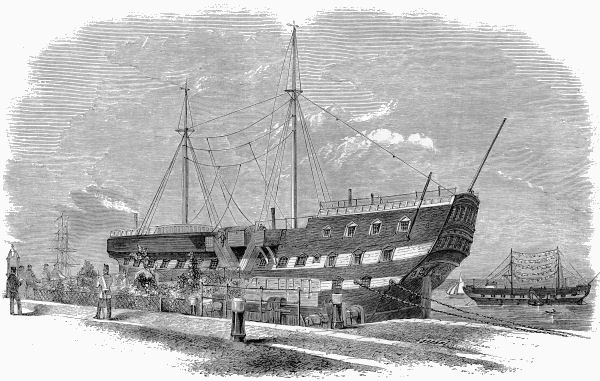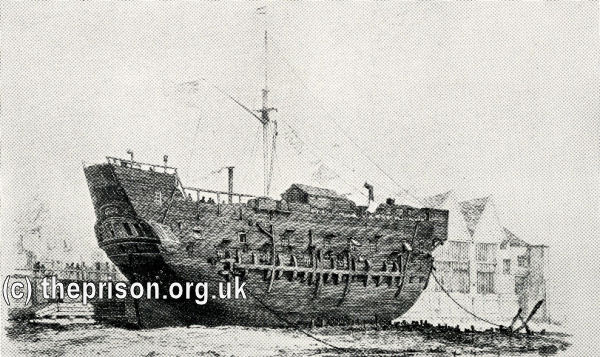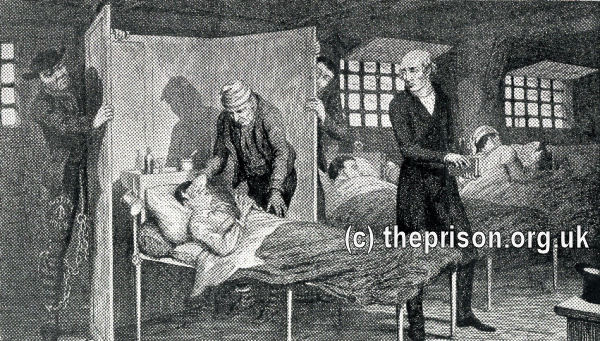Prison Ships
The onset of war with America in 1775 brought an abrupt halt to the steady stream of convict ships that had been heading to its shores. In an effort to deal with the growing backlog of prisoners that had been sentenced to transportation, the Criminal Law Act of 1776, aimed to extend the use of shipboard prisons. It recommended that transportation be replaced by a period of hard labour lasting between three and ten years, with offenders held in houses of correction or 'some proper place of confinement' and fed on a diet of 'bread, and any coarse meat, or other inferior food, and water, or small beer.' Although the Act made no explicit mention of shipboard prisons, the hard labour that it proposed — 'removing sand, soil, and gravel from, and cleansing the River Thames' — made it clear that that was where its intent lay.
In 1776, the contract for supplying and managing the new prison ships, or hulks as they became known, was awarded to Duncan Campbell — one of the merchants who had previously been engaged in transporting convicts to America. Campbell's initial contract was to provide a ship to house 120 prisoners for each of which he was to receive £32 a year. The first vessel he provided, the Justitia, was joined the following year by the Tayloe, the two then accommodating 240 prisoners. The Tayloe was soon replaced by the much larger Censor.

Prison Ship Warrior, Woolwich. © Peter Higginbotham

Prison Ship Discovery at Dartford, 1829. © Peter Higginbotham.
The ships were moored in the middle of the Thames at Woolwich Warren — a mass of foundries, workshops, warehouses and barracks, and a long-established home of naval ship-building and arms manufacture. During the day, prisoners worked at dredging the river or providing labour for building works. At night they were crammed below decks, originally in beds, and then in pairs on low wooden platforms, six feet by four feet. During the day, the platforms were stood on their side and used as tables. An experiment in using hammocks for beds was abandoned after it became apparent how difficult this was while wearing chains.

Hulk inmates returning from shore labour, Woolwich.. © Peter Higginbotham
Conditions on the hulks were dire, with ships sometimes housing up to seven hundred convicts. At night, they were crammed below deck and left in the charge of a single warder. In the first twenty years of their operation, the hulks received around eight thousand prisoners, of which almost a quarter died on board. As well as diseases such as gaol fever, tuberculosis, cholera and scurvy, severe depression appears to have been common. During the first two years of the hulks' operation, one physician commented that some of his patients had died 'merely of lowness of spirit, without any fever or other disorder upon them.'

Death on board Prison Ship Justitia. © Peter Higginbotham.
The lack of progress in building a land-based penitentiary led to a steady growth in the number of hulks required to house the growing convict population. By 1788, the fleet included the Stanislaus at Woolwich, the Dunkirk based at Plymouth, the Lion at Gosport, and the Ceres and La Fortunée at Langstone Harbour, to the east of Portsmouth.
The beginning of transportation to Australia in 1787 did not result in the elimination of the prison hulks which continued in operation for almost as long as transportation itself. The hulks were initially retained to provide temporary accommodation for transportees awaiting a place on an Australian sailing. Some prisoners, though, such as those who proved unfit to make the voyage, ended up serving the whole of their sentence on the hulks.
In 1802, management of the hulks passed from private contractors to the first Inspector of the Hulks, Aaron Graham. Graham issued new orders to for improvements in the domestic routine and hygiene aboard the vessels and in the record-keeping. Officers were no longer to keep pigs or poultry on board for selling meat or eggs to the prisoners. The convicts' daily food allowance was increased, with 'coarse, wholesome meat' now featuring in their diet.
A Select Committee in 1810-11 found that the prisoners' quarters were dens of 'gambling, swearing, and every kind of vicious conversation'. The counterfeiting of coins also went on. However, night-time visual supervision of the men below decks was non-existent. In fact, it seemed 'doubtful whether, in some of the Hulks at least, an officer could go down among the prisoners at night without the risk of personal injury.' After consultation with the Navy Board, a new plan was devised for subdividing the convicts' quarters into a number of separate cells off a central corridor, although it took until 1817 for all the vessels to be fitted out in this way.
Aaron Graham's successor, John Capper, held the post of what became the Superintendent of the Hulks from 1815 to 1847. His main contribution in the early years of his tenure was the introduction of a scheme whereby convicts were classified as 'Very Good', 'Good', 'Indifferent', 'Suspicious', 'Bad', or 'Very Bad'. Prisoners of each class were housed in separate areas of the ship so that, for example, docile inmates would not be bullied by aggressive ones. The classification was subsequently extended to separate youthful offenders from adults, with a separate hulk, the Bellerophon, allocated for boy convicts in 1824.

Former prison ship, Plymouth, late 1800s. © Peter Higginbotham
Further appraisals of the hulks took place in 1828, 1831 and 1835. Despite repeated concerns about the convicts' work being too lenient, and the discipline too lax, little changed. In 1849, overall management of the remaining hulks moved to a new body, the Directors of Convict Prisons. However, the increasing use of land-based prisons saw the hulk fleet continue to shrink until, by 1857, only two vessels remained — the Defence, whose inmates were mostly invalid, and the hospital ship Unité. In July 1857, a fire broke out in the Defence's coal store. Within a few weeks, both vessels had been abandoned and most of their inmates transferred to an old war prison at Lewes in Sussex. So ended the eighty-year-long 'temporary' measure for holding convicts in floating prisons.
Bibliography
- Campbell, Charles The Intolerable Hulks: British shipboard confinement 1776-1857 (2001, Fenestra)
- Johnson, W.B. The English Prison Hulks (1957)
- Higginbotham, Peter The Prison Cookbook: A History of the English Prison and its Food (2010, The History Press)
- Brodie, A. Behind Bars - The Hidden Architecture of England's Prisons (2000, English Heritage)
- Brodie, A., Croom, J. & Davies, J.O. English Prisons: An Architectural History (2002, English Heritage)
- Harding, C., Hines, B., Ireland, R., Rawlings, P. Imprisonment in England and Wales (1985, Croom Helm)
- McConville, Sean A History of English Prison Administration: Volume I 1750-1877 (1981, Routledge & Kegan Paul)
- Morris, N. and Rothman, D.G. (eds.) The Oxfod History of the Prison (1997, OUP)
- Pugh R.B. Imprisonment in Medieval England (1968, CUP)
Links
- Prison Oracle - resources those involved in present-day UK prisons.
- GOV.UK - UK Government's information on sentencing, probation and support for families.
Except where indicated, this page () © Peter Higginbotham. Contents may not be reproduced without permission.



